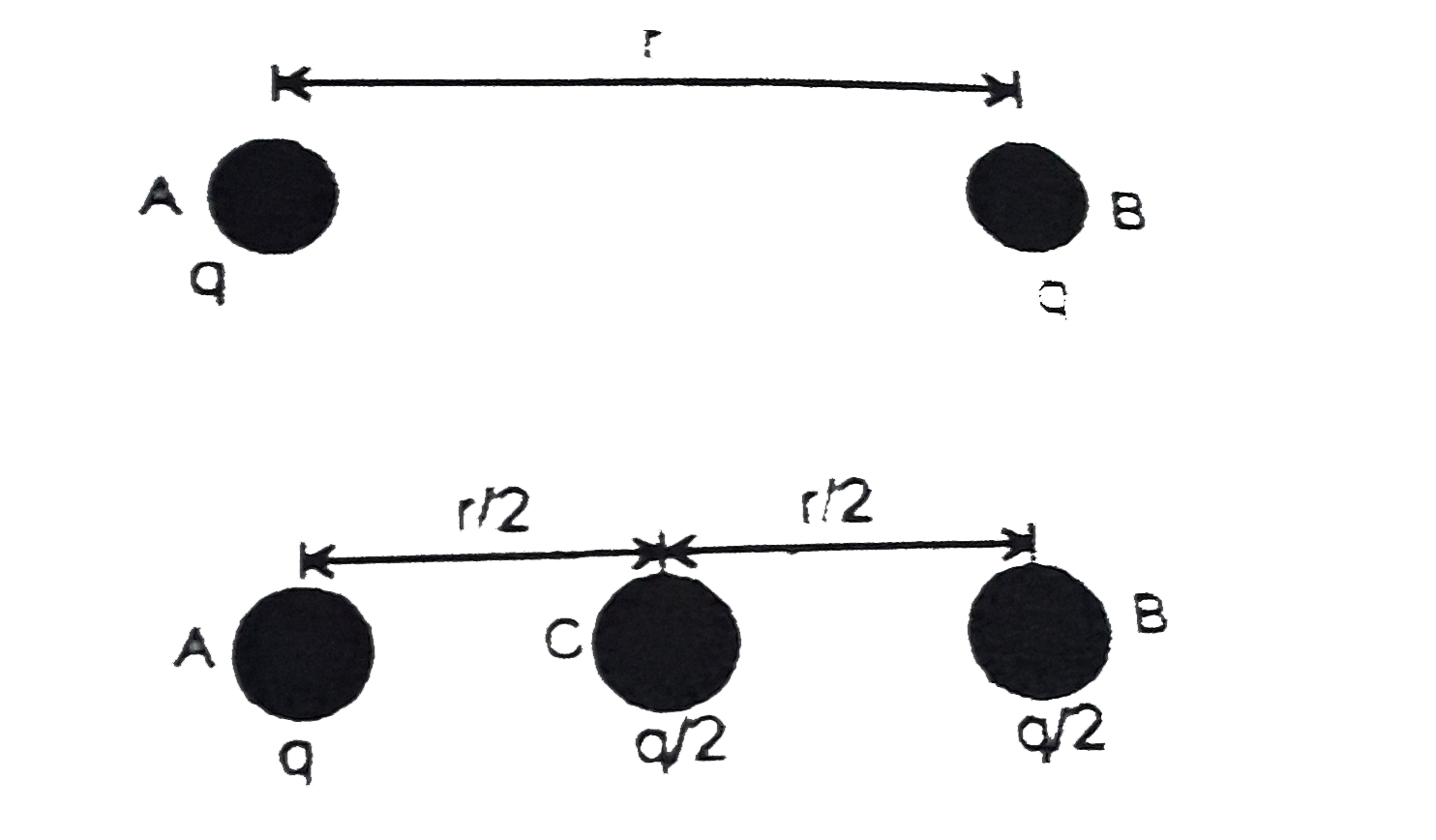Two equally charged, indentical metal spheres A and B repel each other with a force F. The spheres are kept fixed with a distance r between them. A third identical, but uncharged sphere C is brought in contact with A and removed. The magnitude of the net electric force on A is
Let, initially the charge on each sphere be q and separation between their centres be r. Then according to given problem :
=14πε0q×qr2=2×10−5N
When sphere C touches B, the charge of B i.e. q will distribute equally on B and C as sphere are identical how charges on spheres,
qB=qC=(q/2)
So sphere c will experience a force
FCA=14πε0q(q/2)(r/2)2=2F along −−→AB due to charge on A.
and FCB=14πε0(q/2)(q/2)(r/2)2=F, along −−→BA due to charge on B :
So the net forve Fc on C due to charges on A and B
FC=FCA=FCB=2F−F=2×10−5N along −−→AB.

Topper's Solved these Questions
- ELECTROSTATICSBOOK - RESONANCE ENGLISHCHAPTER - ELECTROSTATICSEXERCISE - Problems
22 Videos
- ELECTROSTATICSBOOK - RESONANCE ENGLISHCHAPTER - ELECTROSTATICSEXERCISE - Exercise-1 Section (A)
9 Videos
- ELECTROMAGNETIC INDUCTIONBOOK - RESONANCE ENGLISHCHAPTER - ELECTROMAGNETIC INDUCTIONEXERCISE - A.l.P
19 Videos
- EXPERIMENTAL PHYSICSBOOK - RESONANCE ENGLISHCHAPTER - EXPERIMENTAL PHYSICSEXERCISE - PART -II
10 Videos
Similar Questions
Two equally charged identical metal spheres X and Y repel each other with a force 5⋅10−4⋅ N another identical uncharged sphere C is touched to A and then placed at the mid-point between X and Y. Net electric force on C is
View SolutionTwo similarly and equally charged identical metal spheres A and B repel each other with a force of 2×10−5N. A third identical unchared sphere C is touched with A and then placed at the midpoint between A and B. Find the net electric force on C.
View Solution
Knowledge Check
Two spherical conductors B and C having equal radii and cayying equal charges on them repel each other with a force F when kept apart at some distance. A third spherical conductor having same radius as that B but uncharged is brought in contact with B, then brought in contact with C and finally removed away from both. The new force of repulsion between B and C is
AF/4B3F/4CF/8D3F/8
Two uniform spheres A (Hollow) and B (solid) of same radius R (√125GmPr, where P is _____
View SolutionTwo spherical conductors B and C having equal radii and cayying equal charges on them repel each other with a force F when kept apart at some distance. A third spherical conductor having same radius as that B but uncharged is brought in contact with B, then brought in contact with C and finally removed away from both. The new force of repulsion between B and C is
View SolutionTwo identical conducting spheres A and B, carry equal charge. They are separated by a distance much larger than their diameters, and the force between them is F. A third identical conducting spheres, C,is uncharged. Sphere C is first touched to A, then to B, and then removed. As a result, the force between A and B would be equal to :
View SolutionTwo identical conducting sphere carrying different charges attact each other with a force F when placed in air medium at a distance d apart. The spheres are brought into contact and then taken to their original positions. Now, the two sphere repel each other with a force whole magnitude is equal to the initial attractive force. The ratio between initial charges on the spheres is
View SolutionTwo insulated identically sized charged copper spheres A and B have their centers separated by a distance of 50 cm. A third sphere of the same size but uncharged is brought in contact with the first, then in contact with the second and finally removed from both. What is the new force of repulsion between A and B?
View SolutionTwo chargeed metallic spheres of same size repel each other by a force F. They are now touched with each other and are then separated to same initial distance. Now the force of repulsion is F'. Which of the following are possible?
View SolutionTwo charges of equal magnitudes and at a distance r exert a force F on each other. If the charges are halved and distance between them is doubled, then the new force acting on each charge is
View Solution
